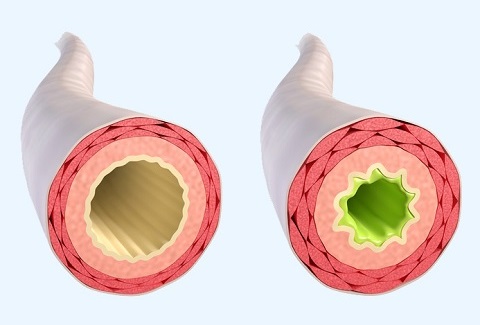Bronchial asthma – Symptoms
How is bronchial asthma identified?
The typical course of bronchial asthma starts with the symptoms of a simple bronchitis. A dry cough and viscous secretions may point to an emerging asthma, especially if they are constantly present for several weeks.
Coughing, viscous secretions, and narrowed airways
Continuous coughing is attributed to the swelling of the mucous membranes in the bronchi. At the same time, the swollen mucous membranes produce an increased amount of mucus that is extremely viscous and sticky. It obstructs the bronchi, interferes with breathing, and thus elicits the dry cough that is typical of bronchial asthma.

Such mucus can hardly be loosened by the cilia, even with the high exhalation speeds produced by bouts of coughing. In addition to swelling of the mucous membranes, many asthmatics also complain about trouble with expectoration of the mucus.
Shortness of breath during an asthmatic attack
When the sensitive bronchial system of asthmatic patients is exposed to additional irritants, this may trigger an asthmatic attack with shortness of breath and heavy coughing. Depending on the patient, such irritants could be specific allergens, or the cause could simply be poor-quality, contaminated air.
Just like coughing, shortness of breath is a result of seriously narrowed bronchi due to swelling of the mucous membranes. This is actually a protective reaction of the airways from infiltrating pollutants. Coughing and increased mucus production should be the fastest way of removing harmful substances from the bronchi. An asthmatic attack causes an overreaction, however: The airways constrict to such an extent that undisturbed respiration is no longer possible.
If an asthmatic attack occurs, the proper response is important!
Quality of life with bronchial asthma
Modern asthma therapy facilitates a relatively symptom-free life for almost all patients. Symptoms can be well controlled thanks to the conventional treatment of bronchial asthma with cortisone and bronchodilating drugs.
The side effects of cortisone are also manageable nowadays, thanks to their administration via inhalation. Inhalative metered-dose therapy has the advantage of transporting the active agent directly to the location of the illness, and can thus be administered in lower doses. Metered-dose therapy has taken the place of systemic administration, in which the drug was administered at higher doses in the form of injections or tablets.
Read more on the topic of bronchial asthma:
Subscribe to our
BREATHE EASY Newsletter
Tips and information on healthy airways!
- for all who wish to breathe better
- free of charge and convenient e-mails
- compact newsletter once a month
For all those who deal with pneumological topics related to the respiratory tract in a professional context, please find here the subscription to the CEGLA FACHNEWSLETTER.

